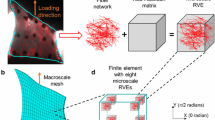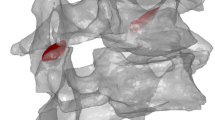Abstract
This study examines axonal changes in goat cervical facet joint capsules (FJC) subjected to low rate loading. Left C5–C6 FJC was subjected to a series of tensile tests from 2 mm to failure using a computer-controlled actuator. The FJC strain on the dorsal aspect was monitored by a stereo-imaging system. Stretched (n = 10) and unstretched (n = 7) capsules were harvested and serial sections were processed by a silver impregnation method. The mean peak actuator displacement was 21.3 mm (range: 12–30 mm). The average peak strain encompassing various regions of the capsule was 72.9 ± 7.1%. Complete failure of the capsule was observed in 70% of the stretched capsules. Silver impregnation of the sections revealed nerve fibers and bundles in all the regions of the capsule. A blinded analysis of digital photomicrographs of axons revealed a statistically significant number of swollen axons with non-uniform caliber in stretched FJCs. Axons with terminal retraction balls, with occasional beaded appearance or with vacuolations were also observed. Stretching the FJC beyond physiological range could result in altered axonal morphology that may be related to secondary or delayed axotomy changes similar to those seen in central nervous system injuries where axons are subjected to stretching and shearing. These may contribute to neuropathic pain and are potentially related to neck pain after whiplash events.





Similar content being viewed by others
References
Bain AC, Raghupathi R, Meaney DF (2001) Dynamic stretch correlates to both morphological abnormalities and electrophysiological impairment in a model of traumatic axonal injury. J Neurotrauma 18(5):499–511
Bain AC, Meaney DF (2000) Tissue-level thresholds for axonal damage in an experimental model of central nervous system white matter injury. J Biomech Eng 122:615–622
Barnsley L, Lord SM, Wallis BJ, Bogduk N (1995) The prevalence of chronic cervical zygapophysial joint pain after whiplash. Spine 20:20–25
Baisden J, Voo LM, Cusick JF et al (1999) Evaluation of cervical laminectomy and laminoplasty. A longitudinal study in the goat model. Spine 24:1283–1288
Bennett GJ, Xie YK (1988) A peripheral mononeuropathy in rat that produces disorders of pain sensation like those seen in man. Pain 33(1):87–107
Brantigan JW, McAfee PC, Cunningham BW et al (1994) Interbody lumbar fusion using a carbon fiber cage implant versus allograft bone. An investigational study in the Spanish goat. Spine 19:1436–1444
Chen CY, Lu Y, Cavanaugh JM, Kallakuri S, Patwardhan A (2005) Recording of neural activity from goat cervical facet joint capsule using custom-designed miniature electrodes. Spine 30(12):1367–1372
Christman CW, Grady MS, Walket CA, Halloway KL, Povlishock JT (1994) Ultrastructural studies of diffuse axonal injuries in humans. J Neurotrauma 11:173–186
DeFelipe J, Jones EG (ed) (1991) Cajal’s degeneration and regeneration of the nervous system, History of neuroscience No 5. Oxford University Press, Oxford
Devor M (1994) The pathophysiology of damaged peripheral nerves. In: Wall PD, Melzack R (eds) Textbook of pain, 3rd edn. Churchill Livingstone, Edinburgh, pp 79–101
Deng B, Begeman PC, Yang KH, Tashman S, King AI (2000) Kinematics of human cadaver cervical spine during low speed rear-end impacts. In: Proceedings of 44th stapp car crash conference, pp 171–188
Dwyer A, Aprill C, Bogduk N (1990) Cervical zygapophyseal joint pain patterns. I: A study in normal volunteers. Spine 15:453–457
Graham DI, Raghupathi R, Saatman KE, Meaney D, McIntosh TK (2000) Tissue tears in the white matter after lateral fluid percussion brain injury in the rat: relevance to human brain injury. Acta Neuropathol 99(2):117–124
Galbraith JA, Thibault LE, Matteson RA (1993) Mechanical and electrical response of the squid giant axon to simple elongation. J Biomech Eng 115:13–22
Gennarelli TA, Thibault LE, Tipperman R, Tomei G, Sergot R, Brown M, Maxwell WL, Graham DI, Adams JH, Irvine A (1989) Axonal injury in the optic nerve: a model simulating DAI in the brain. J Neurosurg 71(2):244–253
Gallyas F, Wolff JR, Bottcher H, Zaborszky L (1980) A reliable method for demonstrating axonal degeneration shortly after axotomy. Stain Tech 55(5):291–229
Igarashi A, Kikuchi S, Konno S (2007) Correlation between inflammatory cytokines released from the lumbar facet joint tissue and symptoms in degenerative lumbar spinal disorders. J Orthop Sci 12(2):154–160
Iwata A, Stys PK, Wolf JA Chen XH, Taylor AG, Meaney DF, Smith DH (2004) Traumatic axonal injury induces proteolytic cleavage of the voltage-gated sodium channels modulated by tetrodotoxin and protease inhibitors. J Neurosci 24(19):4605–4603
Jafari SS, Maxwell WL, Neilson M, Graham DI (1997) Axonal cytoskeletal changes after non-disruptive axonal injury. J Neurocytol 26(4):207–221
Jane JA, Steward O, Gennarelli TA (1985) Axonal degeneration induced by experimental noninvasive minor head injury. J Neurosurg 62:96–100
Kallakuri S, Singh A, Chen C, Cavanaugh JM (2004) Demonstration of substance P, calcitonin gene-related peptide, and protein gene product 9.5 containing nerve fibers in human cervical FJCs. Spine 29:1182–1186
Lee KE, Thinnes JH, Gokhin DS, Winkelstein BA (2004) A novel rodent neck pain model of facet mediated behavioral hypersensitivity: implications for persistent pain and whiplash injury. J Neurosci Methods 137(2):151–159
Lee KE, Davis MB, Mejilla RM, Winkelstein BA (2004) In Vivo cervical facet capsule distraction: mechanical implications for whiplash and neck pain. Stapp Car Crash J 48:373–395
Loeser JD (1985) Pain due to nerve injury. Spine 10(3):232–235
Lord SM, Barnsley L, Wallis BJ McDonald GJ, Bogduk N (1996a) Percutaneous radio-frequency neurotomy for chronic cervical zygapophyseal-joint pain. N Engl J Med 335:1721–1726
Lord SM, Barnsley L, Wallis BJ, Bogduk N (1996b) Chronic cervical zygapophyseal joint pain after whiplash. A placebo-controlled prevalence study. Spine 21:1737–1744
Lu Y, Chen CY, Kallakuri S, Patwardhan A, Cavanaugh JM (2005a) Development of an in vivo method to investigate biomechanical and neurophysiological properties of spine facet joint capsules. Er Spine J 14(6):565–72. doi:10.1007/s00586-004-0835-9
Lu Y, Chen CY, Kallakuri S, Patwardhan A, Cavanaugh JM (2005b) Neurophysiological and biomechanical characterization of goat cervical facet joint capsules. J Orthop Res 23:779–787
Lu Y, Chen CY, Kallakuri S, Patwardhan A, Cavanaugh JM (2005c) Neural response of cervical facet joint capsule to stretch: a study of whiplash pain mechanism. Stapp Car Crash J 49:49–65
McLain RF (1994) Mechanoreceptor endings in human cervical facet joints. Spine 19:495–501
Maxwell WL, Graham DI (1997) Loss of axonal microtubules and neurofilaments after stretch-injury to guinea pig optic nerve fibers. J Neurotrauma 14(9):603–614
Maxwell WL, Povlishock JT, Graham DL (1997) A mechanistic analysis of non-disruptive axonal injury: a review. J Neurotrauma 14(7):419–440
Ono K, Kaneoka K, Wittek A, Kajzer J (1997) Cervical injury mechanism based on the analysis of human cervical vertebral motion and head–neck-torso kinematics during low-speed rear impacts. In: Proceedings of 41st stapp car crash conference, pp 339–356
Ozaktay AC, Cavanaugh JM, Blagoev DC, Getchell TV, King AI (1994) Effects of a carrageenan-induced inflammation in rabbit lumbar FJC and adjacent tissues. Neurosci Res 20(4):355–64
Pearson AM, Ivancic PC, Ito S, Panjabi MM (2004) FJ kinematics and injury mechanisms during simulated whiplash. Spine 29:390–397
Pickar JG, McLain RF (1995) Responses of mechanosensitive afferents to manipulation of the lumbar facet in the cat. Spine 20:2379–2385
Povlishock JT, Christman CW (1995) The pathobiology of traumatically induced axonal injury in animals and humans: a review of current thoughts. J Neurotrauma 12(4):555–564
Povlishock JT, Becker DP (1985) Fate of reactive axonal swellings induced by head injury. Lab Invest 52(5):540–552
Singh A, Lu Y, Chen CY et al (2006) A new model of traumatic axonal injury to determine the effects of strain and displacement rates. Stapp Car Crash Jr 50:601–623
Smith DH, Wolf JA, Lusardi TA, Lee VMY, Meaney DF (1999) High tolerance and delayed elastic response of cultured axons to dynamic stretch injury. J Neurosci 19(11):4263–4269
Tomei G, Spagnoli D, Ducati A Landi A, Villani R, Fumagalli G, Sala C, Gennarelli T (1990) Morphology and neurophysiology of focal axonal injury experiments induced in the guinea pig optic nerve, Acta Neuropathol 80:506–513
Winkelstein BA, Nightingale RW, Richardson WJ, Myers BS (2000) The cervical facet capsule and its role in whiplash injury: a biomechanical investigation. Spine 25:1238–1246
Yamashita T, Cavanaugh JM, El-Bohy AA, Getchell TA, King AI (1990) Mechanosensitive afferent units in the lumbar facet joint. J Bone Joint Surg 72A(6):865–870
Zimmermann M (1985) Functional characteristics of sensory fibers in regenerating cutaneous nerves. In: Delwaide PJ, Gorio A (eds) Clinical neurophysiology in peripehral neuropathies. Elsevier, Amsterdam, pp 41–56
Acknowledgments
This research was supported by CDC grants # R49-CCR519751 and R49-CE000455.
Author information
Authors and Affiliations
Corresponding author
Rights and permissions
About this article
Cite this article
Kallakuri, S., Singh, A., Lu, Y. et al. Tensile stretching of cervical facet joint capsule and related axonal changes. Eur Spine J 17, 556–563 (2008). https://doi.org/10.1007/s00586-007-0562-0
Received:
Revised:
Accepted:
Published:
Issue Date:
DOI: https://doi.org/10.1007/s00586-007-0562-0




